It’s Monday morning. You check GA4, coffee in hand, and see a 22% traffic spike. The numbers look fantastic, up 22% from the previous quarter. You’re already mentally drafting that “mission accomplished” email to your boss.
However, here’s the uncomfortable truth: those numbers might be entirely fictional.
If you’re not actively separating AI traffic in GA4 from genuine human visitors, you’re operating in the dark. AI crawlers, language models scraping your content, and search assistants flood your analytics with noise. The result? Inflated vanity metrics can make your marketing appear successful, but leads and revenue tell a different story.
I learned the hard way when a SaaS client came to me celebrating a 30% traffic increase, only to discover that the actual number of human sessions had declined by 8%. AI bots harvested their knowledge base content. The “growth” was fake.
The good news? Once you track and filter AI web traffic analytics properly, you’ll finally see what’s happening with your audience. More importantly, you’ll spot AI search referrals as an emerging channel that could reshape how people discover your content.
Let’s optimize your analytics and provide you with actionable insights.
Why AI Traffic Matters for GA4 Analytics
Clean Attribution: Your ROI Calculations Are Wrong
When AI crawlers pad your session counts, every marketing metric gets distorted. Your cost-per-click looks artificially low. Your content performance seems inflated. And worst of all, you make budget decisions based on fake engagement.
According to a 2024 study by Imperva, bad bots now account for 32% of all website traffic, before factoring in GPTBot, ClaudeBot, Google-Extended, and other AI assistants that assist users with research.
Think about it: if a third of your “visitors” are robots, your conversion rate calculations are off by 50% or more. No wonder your marketing attribution feels like guesswork. Clean attribution becomes impossible when analytics distortion runs this deep.
Visibility Into AI Search: The New Discovery Layer
Not all AI traffic is bad traffic. When someone asks ChatGPT or Claude a question and clicks through to your site, a legitimate human visit occurs. They found you through an AI intermediary instead of Google.
AI search referrals represent a fundamentally discovery mechanism. Early data indicate that users who discover content through AI assistants have higher intent and spend more time engaging. You’ll miss these trends if everything gets lumped into “direct traffic” or filtered out.
Content Protection: Know When Your IP Gets Scraped
AI models need training data, and your carefully crafted content is prime real estate. Aggressive scrapers harvest your content without permission.
Bot traffic analysis helps you make informed decisions about robot.txt configurations, rate limiting, and content protection strategies.
Credibility With Leadership: No More Embarrassing Board Meetings
Nothing tanks your credibility faster than presenting traffic growth that doesn’t translate to business results. When your CEO asks why leads are flat despite record website visits, “maybe it’s bot traffic” isn’t the confident answer they’re looking for.
Clean GA4 AI traffic tracking enables you to enter executive meetings with numbers that truly matter.
The Difference Between AI Search Referrals and AI Crawlers
Before we dive into the technical setup, understand what we’re measuring. Two distinct types of AI traffic hit your site:
AI Search Referrals are valuable traffic. Human users ask AI assistants questions, the AI recommends your content, and people click through. The visitor is 100% human using AI as a research tool.
AI crawlers automatically: AI crawlers, such as GPTBot, ClaudeBot, and Google-Extended, automatically scrape your content for training data, indexing, or analysis. No human participates. They exhibit patterns such as lightning-fast page loads, minimal mouse movement, and systematic URL crawling.
You want to measure AI search referrals (new channel!) and filter out AI crawlers (pure noise). Most setups treat both identically, creating analytics distortion.
Step-by-Step: How to Separate AI Traffic in GA4 from Real Human Visits.
Step 1: Create an AI Search Channel Group
How to Track ChatGPT, Perplexity, Claude & Copilot Traffic in GA4
If you’re getting traffic from AI search assistants like ChatGPT, Perplexity, Claude, or Microsoft Copilot… you’re probably missing it in your GA4 reports.
By default, GA4 buckets this traffic into Referral or Unassigned, which means you can’t measure AI-driven discovery. Here’s how to fix that by creating a dedicated AI Search channel:
Step 1: Create a New Channel Group
- In GA4, go to Admin → Data display → Channel groups
- Click Create New Cchannel Group and name it something like SEO + AI Search Tracking
Step 2: Add Your AI Sources (the key step)
- Inside your new Channel Group, click Add New Channel and name it AI Search.
- Under Channel conditions, choose Source from the dropdown.
- Add the following as OR conditions:
- Source contains chatgpt.com
- Source contains chat.openai.com
- Source contains perplexity.ai
- Source contains claude.ai
- Source contains copilot.microsoft.com
- Source contains gemini.google.com
- Source contains bard.google.com
- Source contains you.com
- Source contains andisearch.com
- Source contains grok.com
- (This list future-proofs you for the major AI search referrers. Note: Currently, you can only add up to 10 sources to a new channel group. You can set up Regex Filter Reporting (see instructions below)
- Click Save Group → Save Channel — these rules tell GA4 to bucket all sessions from these domains into your new AI Search channel.
💡 Pro tip: If you discover other AI tools sending traffic (e.g., pi.ai), add them here anytime.
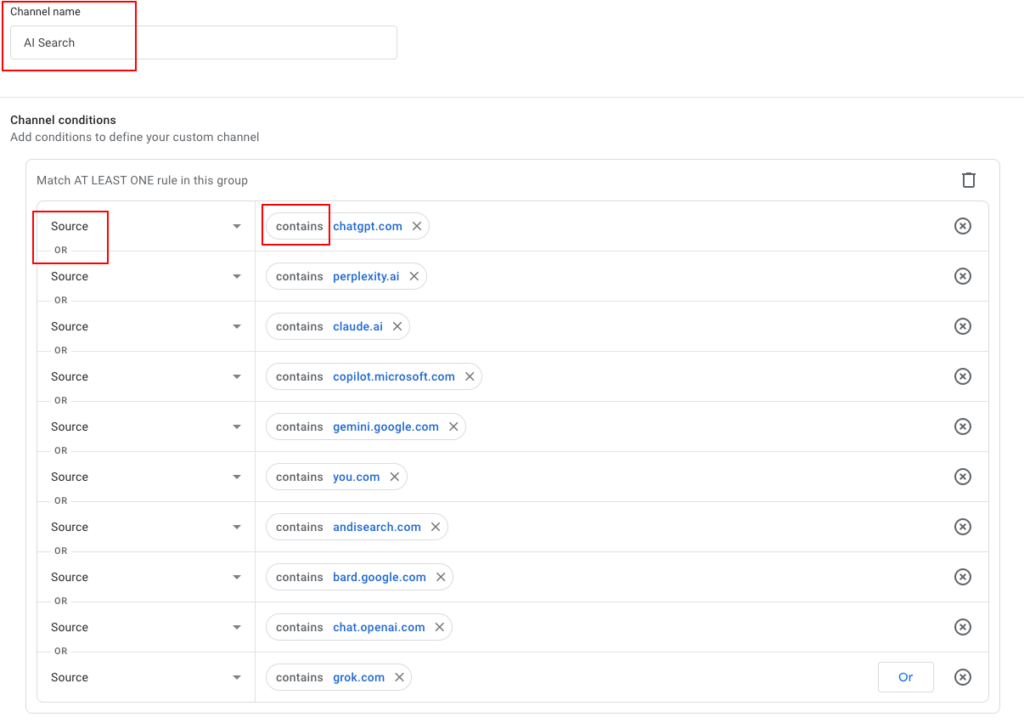
Step 3: Apply & View in Reports
- Go back to Reports → Acquisition → Traffic acquisition.
- Change the dropdown filter from Session default channel group to your new SEO + AI Search Tracking group.
- You’ll now see AI Search appear as its row alongside Organic Search, Direct, Referral, etc., with full session, engagement, and conversion data.
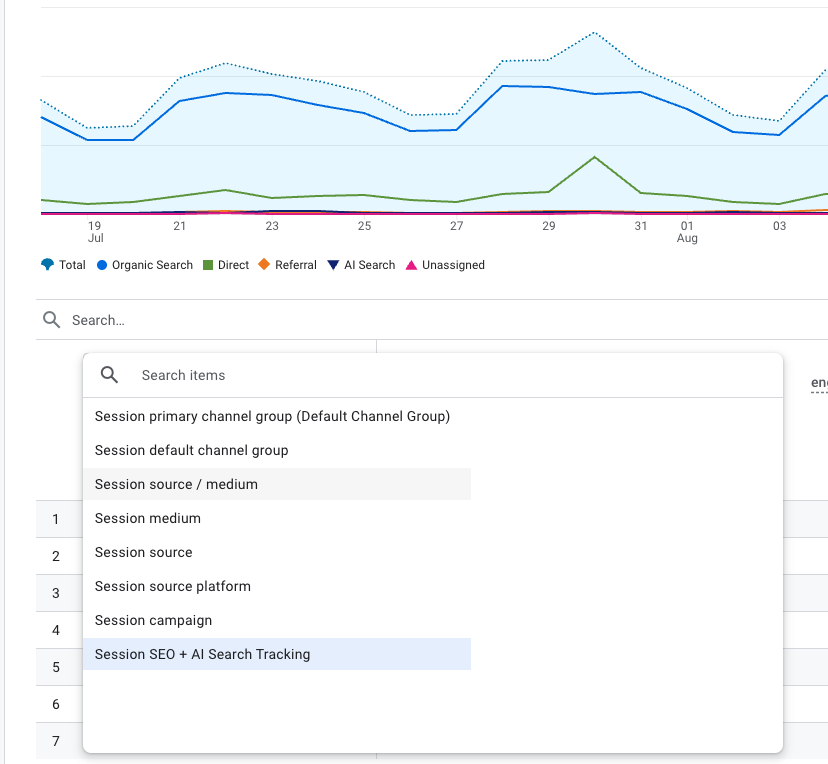
Why This Matters
- You can now measure exactly how much traffic AI search tools send you
- Track engagement, conversions, and trends for this emerging channel
- Make better decisions about optimizing content for AI-driven discovery
If AI assistants are rewriting how people find answers, we should track them with the same rigor as we track Google Search.
Tracking AI Search Traffic in GA4 Using Explorations
If you want to understand how much of your traffic comes from AI search engines like ChatGPT, Perplexity, Claude, Grok, and DeepSeek, you can set up a GA4 Exploration with a regex filter to isolate these referrals.
Step 1: Create a New Exploration
- Go to Explore in GA4.
- Click + and choose Blank Exploration.
- Name it something like AI Search Traffic Tracking.
Step 2: Add Dimensions and Metrics
- Dimension: Add Session source (or Source).
- Metric: Use Active Users for accuracy.
- (Optional: also add Engaged Sessions, Event Count, or Conversions.)
Step 3: Configure the Exploration
- Drag Session source into Rows.
- Drag Active Users into Values.
Step 4: Apply a Regex Filter
To capture AI-driven search traffic, add a filter:
- In the right panel, click Filters.
- Choose Session source → Matches Regex.
- Paste this regex pattern:
Copy & Paste This Regex Pattern Below
(chatgpt\.com|chat\.openai\.com|perplexity\.ai|claude\.ai|copilot\.microsoft\.com|gemini\.google\.com|bard\.google\.com|you\.com|andisearch\.com|grok\.com|deepseek\.com)
- Click Apply.
Step 5: Analyze AI Traffic
Your report will now show Active Users coming from these AI sources, letting you measure:
- Which AI search tools are driving traffic?
- Which landing pages do users hit?
- How engaged these visitors are.
Pro Tip
Use the same regex in your custom GA4 Channel Group for SEO + AI Search Tracking. Using the same regex keeps your reporting consistent across standard reports and Explorations.
Why This Matters
- Keeps your AI traffic tracking unified across all GA4 reports
- Prevents mismatched numbers between Explorations and standard Acquisition reports
- Saves time by managing a single regex instead of updating multiple filters
- Gives you a reliable view of how AI search referrals contribute to engagement and conversions
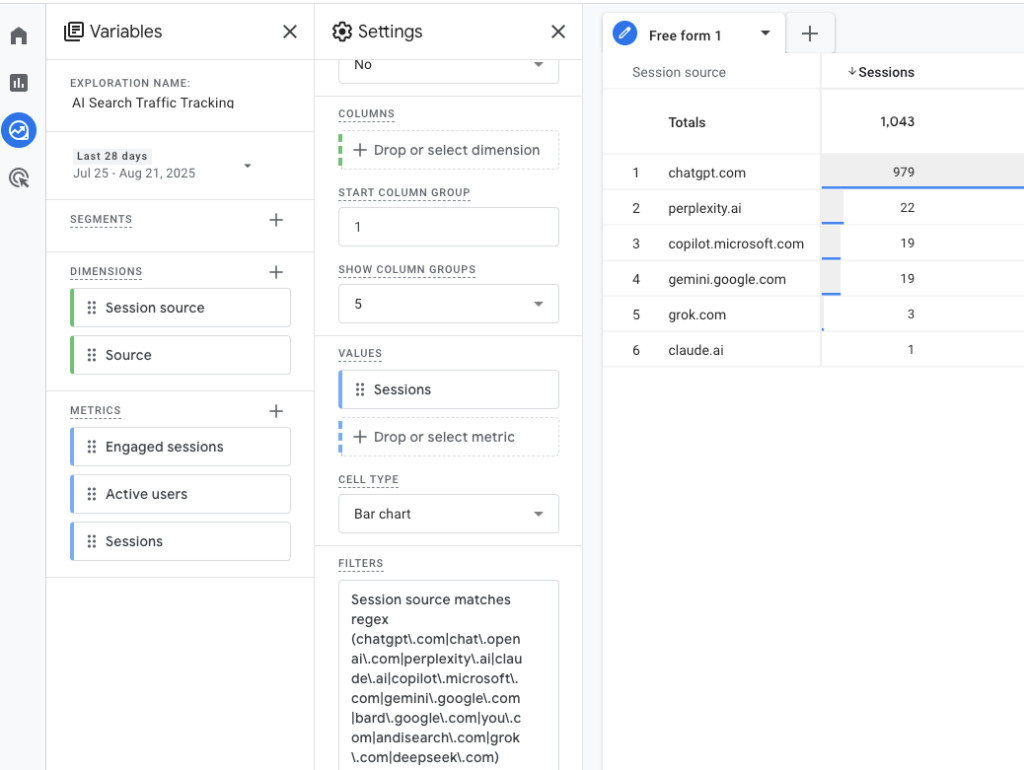
Step 2: Block Known AI Crawlers in Google Tag Manager
Create a custom variable in GTM to detect known AI bot user agents like GPTBot, ClaudeBot, and Google-Extended:
## JAVASCRIPT CODE ##
function() {
try {
var ua = navigator.userAgent ? navigator.userAgent.toLowerCase() : "";
// Expand as new crawlers emerge
var patterns = /(gptbot|claudebot|perplexity|google-extended|ccbot|ai2bot|cohere|anthropic)/i;
var webdriverFlag = false;
try { webdriverFlag = navigator.webdriver === true; } catch(e) {}
return patterns.test(ua) || webdriverFlag;
} catch(e) {
return false;
}
}## END JAVASCRIPT CODE ##
Then, add a trigger exception that prevents GA4 tags from firing when the variable returns a valid value. The exception prevents obvious crawlers from polluting your data while allowing legitimate AI referral traffic to pass through.
Step 3: Flag Suspicious Sessions with GA4 Parameters
Not all bots announce themselves clearly. Set up custom parameters to flag suspicious behavior patterns:
- Page Load Speed: Sessions with average page load times under 100ms
- Session Duration: Visits lasting exactly 0 seconds or following unnatural patterns
- Mouse Movement: Sessions with no recorded interaction events
- Sequential Crawling: Visitors accessing URLs in alphabetical or systematic order
Send these signals to GA4 as custom parameters, allowing you to analyze patterns and refine your filtering rules.
Step 4: Build GA4 Audiences (Human, AI Referrals, Crawlers)
Create three distinct audiences:
- Verified Human Traffic: Sessions with interaction events, reasonable page load times, and organic behavior patterns
- AI Search Referrals: Human sessions that originated from AI-powered tools and assistants
- Suspected Crawlers: Automated sessions flagged by your detection rules
Segmentation enables you to analyze each type of traffic separately and understand its unique characteristics.
Step 5: Use BigQuery for Clean Session Labeling
For the most sophisticated approach, export your GA4 data to BigQuery and apply machine learning models to classify sessions. Google’s AutoML can identify bot patterns with 95%+ accuracy once you train it on your specific traffic patterns.
The investment is overkill for most organizations, but if clean attribution is critical to your business (think enterprise SaaS or e-commerce), the investment pays dividends.
Step 6: Optional BigQuery Labeling for Deeper Accuracy
Purpose: Generate a session-level label for robust dashboards. This approach is ideal if you need bulletproof attribution in Looker Studio or enterprise BI tools.
A. Link BigQuery
- In GA4 Admin → BigQuery links, connect your GA4 property to a BigQuery project.
B. Run a Daily Query to Tag Sessions
Here’s an example query pattern:
WITH sessions AS (
SELECT
user_pseudo_id,
MIN(event_timestamp) AS session_start,
SUM(CASE WHEN event_name = 'page_view' THEN 1 ELSE 0 END) AS pv,
SUM(CASE WHEN event_name IN ('scroll','file_download','click','view_search_results') THEN 1 ELSE 0 END) AS interact_events,
MAX(IF(event_name = 'page_view',
(SELECT value.int_value FROM UNNEST(event_params) WHERE key = 'engaged_session_event'), 0)) AS engaged_flag,
MAX(IF(event_name = 'page_view',
(SELECT value.string_value FROM UNNEST(event_params) WHERE key = 'ai_bot'), '')) AS ai_bot_flag,
MAX(IF(event_name = 'page_view',
(SELECT value.string_value FROM UNNEST(event_params) WHERE key = 'ai_suspect'), '')) AS ai_suspect_flag
FROM `PROJECT.DATASET.events_*`
WHERE _table_suffix BETWEEN '20250801' AND '20250831'
GROUP BY user_pseudo_id
)
SELECT
*,
CASE
WHEN ai_bot_flag = 'true' THEN 'AI crawler'
WHEN ai_suspect_flag = 'true' THEN 'AI crawler'
WHEN engaged_flag = 0 AND pv >= 5 AND interact_events = 0 THEN 'AI crawler'
ELSE 'Human'
END AS traffic_label
FROM sessions;Outcome:
You now have a clean session-level label (Human vs AI crawler) for dashboards in Looker Studio and ad-hoc analysis. Running session-level labeling in BigQuery ensures leadership dashboards reflect real human traffic rather than bot noise.
Real-World Example: The 18% Traffic Spike That Wasn’t
A nonprofit client came to me, thrilled about their recent increase in traffic. Their monthly organic visits had jumped from 45,000 to 53,000, an 18% increase that looked fantastic in their board presentation.
But once we applied GA4 bot filtering and segmented the data, the real story came out:
- Human organic traffic: 42,000 visits (down 7% from the previous month)
- AI search referrals: 3,200 visits (brand new channel worth monitoring)
- AI crawlers: 7,800 visits (pure noise that needed filtering out)
The ‘growth’ was fake. Human traffic dropped 7%, signaling the SEO strategy was failing. Without separating AI traffic, the team would have celebrated while the real audience disappeared.
The AI referral traffic, however, told a different story. Visitors arriving through AI assistants stayed 2.3 times longer and were 40% more likely to download educational resources. That insight led us to create a content strategy designed for AI-powered discovery – a shift that helped the nonprofit reach a more engaged audience.
How to See Pages Getting AI Referral Traffic in GA4
- Switch to Pages Report
- In GA4, go to Reports → Engagement → Pages and screens.
- This report shows all the landing pages users enter through.
- Add a Filter for AI Search
- At the top, click the + Add filter option.
- Set:
- Dimension: Session default channel group
- Match Type: exactly matches
- Value: AI Search (your custom channel group).
- Confirm the Dimension
- Make sure the main dimension in the table is Landing page + query string.
- This will display all the exact URLs (with parameters if any).
- Analyze and Export
- You’ll now see the full list of URLs AI tools are sending traffic to.
- Export the table if you want to analyze it further in Excel/Sheets.
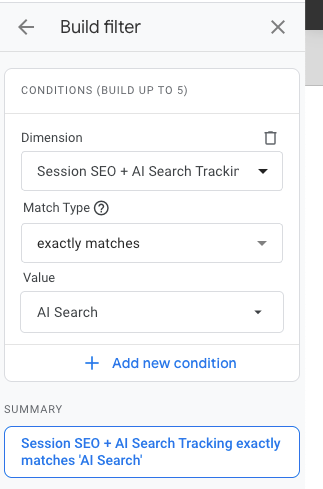
Future Trends in AI Search and Analytics
AI Search as a Channel
Within 18 months, AI search referrals will become a standard reporting category alongside organic, social, and paid channels. Early movers who optimize their content for AI discovery will build significant competitive advantages.
The strategy involves writing content that directly addresses complex questions, structuring information in a way that AI models can easily parse, and establishing relationships with AI platform operators.
Crawler Intensity Spikes
As more AI models enter training cycles, expect periodic surges in crawling activity. Understanding these patterns helps you plan server capacity and identify when new AI systems index your content.
Mentions vs Citations
Traditional SEO focuses on backlinks, but AI search operates on mentions and references. Your content might influence thousands of AI-generated responses without generating a single trackable link. New measurement approaches will be needed to capture the value.
Executive Reporting Standard
Within 24 months, separating human and AI traffic will become a standard expectation in executive dashboards. CFOs and CEOs will demand clean attribution data, and marketing teams that can’t provide it will lose credibility.
Getting ahead of the trend positions you as a sophisticated operator who understands the evolving digital landscape.
FAQ: AI Traffic in GA4
Does GA4 automatically filter AI bots?
GA4 has basic bot filtering enabled by default; however, it doesn’t reliably catch modern AI crawlers, such as GPTBot, ClaudeBot, or Google-Extended, nor most AI assistants and content scrapers. It doesn’t catch modern AI assistants, content scrapers, or research tools. You need custom filtering for comprehensive coverage.
Are AI referrals beneficial or detrimental to my business?
AI referrals from legitimate research and discovery are valuable, as they represent real humans discovering your content through AI-powered tools. However, you should track them separately from traditional organic traffic to understand their unique conversion patterns and behavior.
Can I block AI crawlers completely?
Technically, yes, but it’s not always wise. Some AI crawling helps your content get discovered through AI search tools. The goal is measurement and segmentation, not complete blocking. Focus on filtering analytics data rather than blocking all access.
How do I know if my traffic is human?
Look for interaction signals, such as mouse movements, scroll behavior, form submissions, reasonable session durations, and natural page view patterns. Humans rarely load 50 pages in 30 seconds or spend exactly 0 seconds on every page.
Executive Takeaway: Leadership Credibility Is On the Line
The explosion of AI tools fundamentally changes how we measure the success of digital marketing. Teams that separate human vs AI traffic today build significant advantages over competitors flying blind.
However, what matters is that your leadership credibility depends on accurate reporting.
Organizations that master clean attribution will:
- Report accurate ROI to boards without embarrassing gaps between traffic and revenue
- Spot AI search as an emerging channel before competitors
- Protect content value through informed IP strategies
- Build executive trust through sophisticated analytics
Companies celebrating bot-inflated metrics will discover that their human audience has declined while they weren’t watching.
My prediction: Within 12 months, any marketing deck that fails to distinguish between human and AI traffic will appear amateurish to boards and investors. Leadership teams I advise already ask these questions.
Don’t let analytics distortion tank your credibility.
Start separating human and AI traffic in GA4 today. Clean reporting builds trust with your board and gives you the clarity to make smarter strategic decisions.
Related Articles:
The Truth About AI-Driven SEO Most Pros Miss
Intent-Driven SEO: The Future of Scalable Growth
SEO Strategy for ROI: A Better Way to Win Big
Future of SEO: Unlocking AEO & GEO for Smarter Growth
Skyrocket Growth with Keyword Strategy for Founders
Unlock Massive Growth with This 4-Step SEO Funnel
About the Author
I write about:
- AI + MarTech Automation
- AI Strategy
- COO Ops & Systems
- Growth Strategy (B2B & B2C)
- Infographic
- Leadership & Team Building
- My Case Studies
- Personal Journey
- Revenue Operations (RevOps)
- Sales Strategy
- SEO & Digital Marketing
- Strategic Thinking
📩 Want 1:1 strategic support?
🔗 Connect with me on LinkedIn
📬 Read my playbooks on Substack
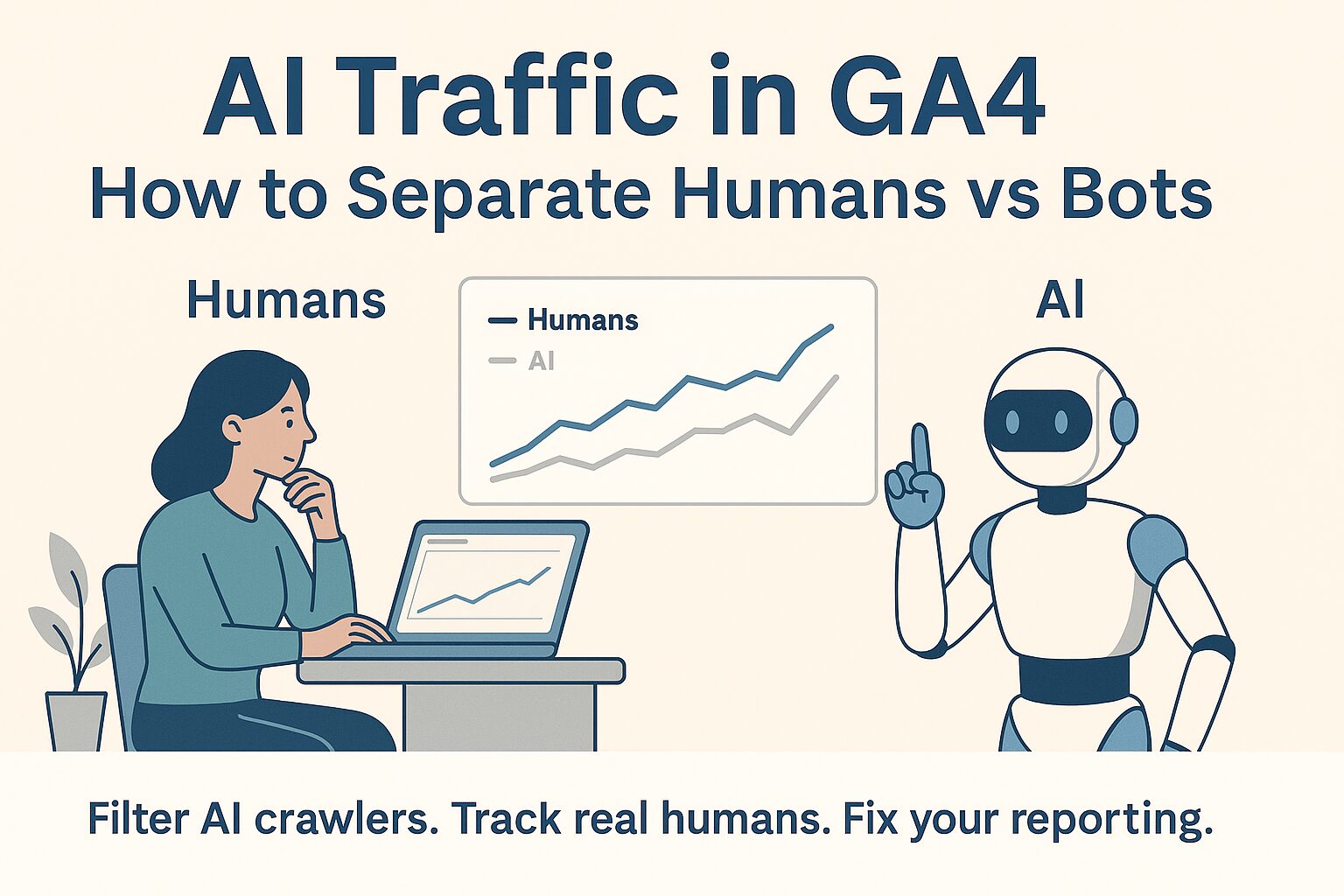
Leave a Reply